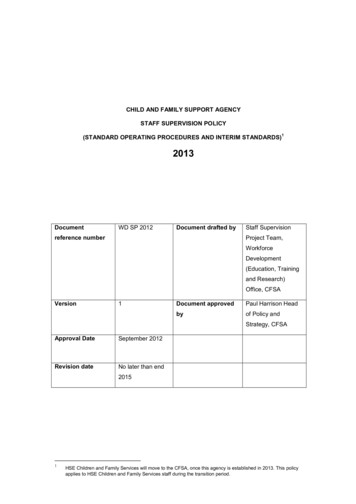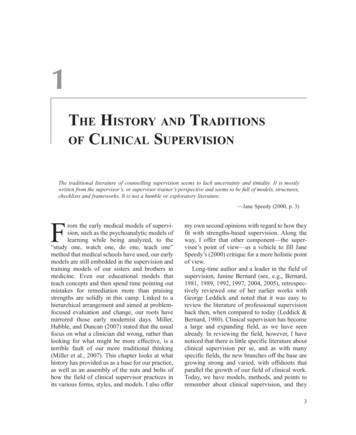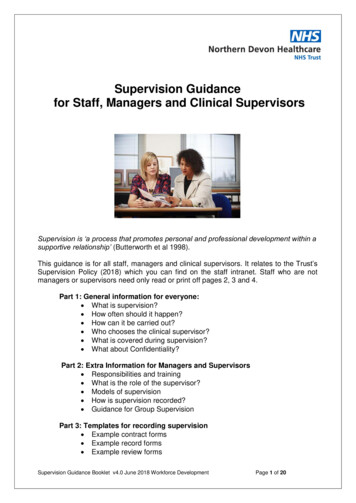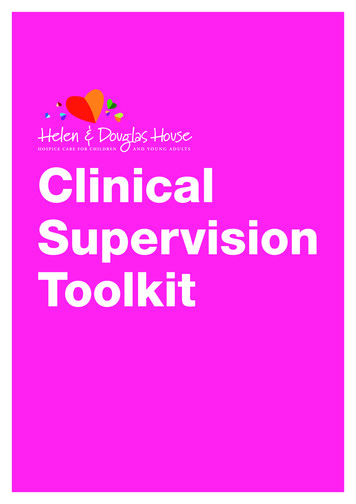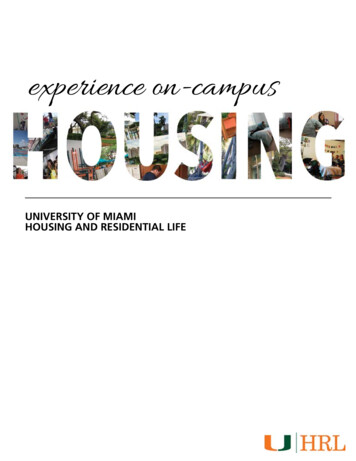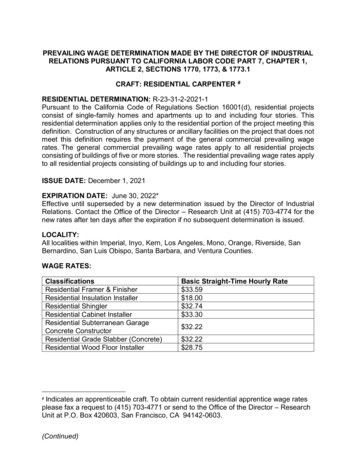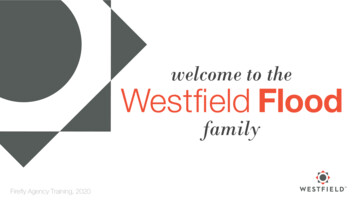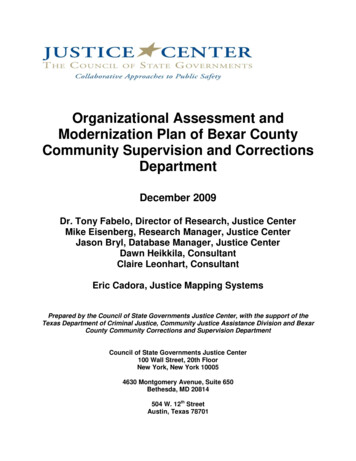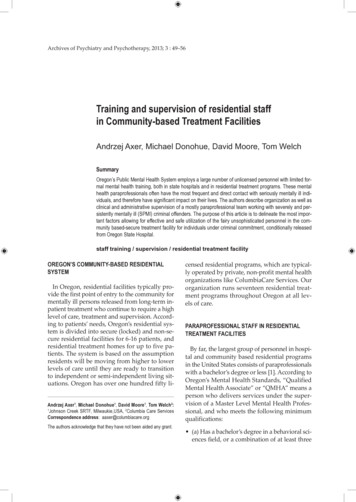
Transcription
Archives of Psychiatry and Psychotherapy, 2013; 3 : 49–56Training and supervision of residential staffin Community-based Treatment FacilitiesAndrzej Axer, Michael Donohue, David Moore, Tom WelchSummaryOregon’s Public Mental Health System employs a large number of unlicensed personnel with limited formal mental health training, both in state hospitals and in residential treatment programs. These mentalhealth paraprofessionals often have the most frequent and direct contact with seriously mentally ill individuals, and therefore have significant impact on their lives. The authors describe organization as well asclinical and administrative supervision of a mostly paraprofessional team working with severely and persistently mentally ill (SPMI) criminal offenders. The purpose of this article is to delineate the most important factors allowing for effective and safe utilization of the fairy unsophisticated personnel in the community based-secure treatment facility for individuals under criminal commitment, conditionally releasedfrom Oregon State Hospital.staff training / supervision / residential treatment facilityOregon’s Community-based ResidentialSystemIn Oregon, residential facilities typically provide the first point of entry to the community formentally ill persons released from long-term inpatient treatment who continue to require a highlevel of care, treatment and supervision. According to patients’ needs, Oregon’s residential system is divided into secure (locked) and non-secure residential facilities for 6-16 patients, andresidential treatment homes for up to five patients. The system is based on the assumptionresidents will be moving from higher to lowerlevels of care until they are ready to transitionto independent or semi-independent living situations. Oregon has over one hundred fifty liAndrzej Axer1, Michael Donohue1, David Moore1, Tom Welch2:1Johnson Creek SRTF, Milwaukie,USA, 2Columbia Care ServicesCorrespondence address: aaxer@columbiacare.orgThe authors acknowledge that they have not been aided any grant.censed residential programs, which are typically operated by private, non-profit mental healthorganizations like ColumbiaCare Services. Ourorganization runs seventeen residential treatment programs throughout Oregon at all levels of care.Paraprofessional Staff in ResidentialTreatment FacilitiesBy far, the largest group of personnel in hospital and community based residential programsin the United States consists of paraprofessionalswith a bachelor’s degree or less [1]. According toOregon’s Mental Health Standards, “QualifiedMental Health Associate” or “QMHA” means aperson who delivers services under the supervision of a Master Level Mental Health Professional, and who meets the following minimumqualifications: (a) Has a bachelor’s degree in a behavioral sciences field, or a combination of at least three
50Andrzej Axer et al.year’s work, education, training or experience;and (b) Has the competencies necessary to: (A) Communicate effectively; (B) Understand mental health assessment,treatment and service terminology and toapply the concepts; (C) Provide psychosocial skills development; and (D) Implement interventions prescribed ona treatment plan [2]).In reality, staff designated as QMHAs consistof a wide variety of individuals whose educationencompasses bachelor’s degrees in psychology,special education or criminal justice. These individuals may come to work straight from college or are persons with no high school diploma but with many years’ experience in in themental health field. Considering the fact such adiverse pool of employees with limited formalprofessional training plays such a critical rolein providing residential treatment services, it isworth describing factors that allow them to function competently as members of the rehabilitation team. Empirical evidence shows effectiveteamwork is associated with less staff burnout,more optimistic attitudes about rehabilitation,and better clinical outcome [3]. Competent teamswhich individualize their services to the specificneeds of each patient must develop mechanismsto support their overall mission, develop clearorganizational structure, have strong leadership,define critical staff competencies, provide relevant training and positive supervision, encourage collaborative problem solving among teammembers, and monitor implementation of individualized treatment plans [4]. In the followingsegments, the authors will review these criticalelements separately.Program MissionRecovery-based residential treatment programs have a common mission of helping individuals with severe psychiatric disabilitiesachieve greater personal autonomy and improved social functioning. The overall goal isto gradually replace external control with patients’ self-directed action, without jeopardizing patients’ personal safety. Residential teamsare charged with the task of creating and maintaining flexible and gently challenging learningenvironments where residents are encouragedto try new things that seemed to be out of theirreach before.Organizational StructureThe program directed by the authors of this article provides a comfortable residence, psychiatric treatment and rehabilitation to eight individuals with severe mental illness under conditional release agreement from the Oregon StateHospital. The team leaders are an experiencedpsychiatrist, a doctoral-level professional psychologist, administrator with certification in psychiatric rehabilitation, and assistant administrator with several years of experience in both residential and acute inpatient psychiatric settings.The core team of residential staff consists of tenfull time QMHAs and five QMHAs serving asextra help (to cover vacations and leave time ofregular employees). The team provides intensive, structured rehabilitation programming foran average of twenty hours a week per each individual patient. The treatment schedule is highly predictable with designated times for groupand individual interactions with residents. Skillstraining and therapy groups are conducted every weekday, always at the same time in the midmorning and mid-afternoon. Consistency andpredictability of group scheduling is a key factor allowing residents to show up on time. Eachweekday, in the early afternoon, residents practice social skills in the community individually under the guidance and supervision of an assigned staff member. Evening hours are dedicated to recreation and physical exercises. Weekends are relaxed and include community basedplanned group activities.Consistent structure is no less important forstaff than it is for residents. There are alwaystwo QMHAs on each 8-12 hour shift. Daily routines for shift partners are listed in chronological order from the beginning to the end of theirshift. This “Daily road map” includes signing in,checking out a key, reading messages, countingmeds; walking through and greeting each resident; checking in with a shift partner to planspecific duties and break; working along withArchives of Psychiatry and Psychotherapy, 2013; 3 : 49–56
Training and supervision of staff in Comunity-based Treatment Facilitiesresidents to assist them with their tasks; sittingdown by the table and socializing with residentsduring meals; administering all scheduled medications; reaching out to residents and engagingthem in casual conversations; supporting andmonitoring residents during community outings; debriefing community skills practice witheach resident right after returning home; writing progress notes for activities consistent withtreatment plans; taking a break; passing important information to the next shift; and saying“Good Bye” to residents before going home.Program Leadership Responsibilities51ful emotional responses staff might have to theirresidents or to each other [5].Aside from the program psychiatrist, otherprogram leaders include the program administrator, the assistant administrator, and the clinical supervisor. The program administrator isresponsible for maintaining the consistency ofall daily operations with the program mission.His duties include protecting the physical andemotional safety of residents and staff, hiringnew personnel, enforcing proper work habits,responding to residents’ complaints, facilitatingstaff meetings, and approving program expenditures. The assistant administrator is responsible for maintaining adequate staff coverage, approving leave requests; coordinating staff initialorientation; keeping personnel files in order; andmonitoring house expenditures. The clinical Supervisor designs treatment plans for each resident, conducts individual and group therapysessions, and facilities monthly treatment planreviews for each resident. He also provides regular clinical supervision of QMHA staff, givingthem concrete written directions on how to assistresidents in achieving specific objectives listed intheir individualized treatment plans (Tab. 1).Program leaders meet weekly to review outstanding clinical and operational issues. In allroutine situations, program leaders obtain feedback from residential staff prior to making decisions and leave QMHAs some flexibility on howto complete their assignments. A more directivestyle of management is used only in time of crisis, in dealing with legal liabilities, and in mostfinancial matters.Roles of program leaders are clearly delineated so all QMHA team members know who is responsible for what. A program psychiatrist, whois also the company’s medical director, providesmedical oversight of the overall program andconducts regular medication management andtherapy sessions with each resident. It is worthmentioning that unlike in many other community mental health agencies in Oregon, the psychiatrist treating residents of ColumbiaCare Servicescould be considered a model of a highly trainedmedical leader who seriously considers staff observations and asks for their opinions before making clinical decisions. The psychiatrist, board-certified in both general and forensic psychiatry, isnot only permitted but encouraged by the executive leadership to utilize his full array of clinicalskills, avoiding being associated solely with theprescription of medications.The program psychiatrist also plays a significant role in modeling for staff Table 1: Example of two treatment objectives and recommended interventionsbotha collaborative approachRecommended interventions to be usedand expressing genuine inter- Resident’s Treatment Objectiveby QMHA staffest in residents. It must be emphasized that a program psy- Resident will use coping skills to reduce Teach self-monitoring of symptoms;demonstrate and coach in using copingchiatrist, who is highly respect- anxiety and suspiciousness asskills, including relaxation, yoga, etc.;ed by all staff, makes an impor- evidenced by anxiety and suspiciousteach how to use perception check; extant contribution to the team ness scores at or below point 2 on theplore alternative explanations of eventsdevelopment and participates BPRS scale [6].causing suspiciousnessin staff meetings and trainingParaphrase and check for understandsessions. Periodically the psy- Resident will express his thoughts cochiatrist facilitates a Balint-like herently as evidenced by scores at point ing; encourage resident to break downcomplex thoughts in brief sentences;group with the entire staff of the 2 on conceptual disorganization scale ofteach how to use correct wordsprogram to address any power- the BPRS and at point 4 of MCAS Soin a proper context; practice conversacial Effectiveness Scale [7].Archives of Psychiatry and Psychotherapy, 2013; 3 : 49–56tional skills in real life situations
52Andrzej Axer et al.QMHAs ResponsibilitiesQMHA staff members in residential treatmentprograms function in two basic roles, as caregivers and as skills trainers. Caregiving functionsare necessary to maintain residents’ health, safety and basic comfort. One example is administering medications to residents who are not yetcapable of doing so themselves. Shopping, preparing meals and housekeeping are also ultimately the responsibility of QMHAs, althoughresidents are encouraged to assist them. Othertasks in this category include checking on residents at night, assisting with monthly fire drills,and transporting residents to the community formedical appointments or family visits. In addition, each QMHA is responsible for the implementation of the service plans which addressspecific care, safety and supervision needs of individual residents.As skills trainers, instead of providing directassistance, QMHAs train residents in those skillsconsidered essential for transition to less structured living situations. Social skills training interventions correspond with each resident’s goalsfor community living as part of their individualized treatment plans. Each QMHA must be ableto support the implementation of these individualized treatment plans by encouraging residentsto learn a particular new skill, and by providingdemonstration, teaching problem-solving strategies, and coaching residents in practicing newly learned skill[s] both in a classroom environment and in real-life situations. It is importantto mention that QMHAs must maintain a properbalance between teaching and caregiving functions depending on residents’ changing physical and psychiatric conditions. However, all staffare expected to always look to maximize learning opportunities and avoid disempowering capable residents.In order to create a safe and relaxed residential treatment environment, QMHAs are expected to treat residents attentively in a polite andadult manner. Use of humor, spontaneity andlimited self-disclosure in the interest of residentneeds are strongly encouraged. Each staff member must spend sufficient time with residents,keep promises, and seek reasonable compromises to avoid power struggles. Emphasizing safety,common sense and collaborative decision-mak-ing instead of enforcing compliance is a coreprinciple for all staff.QMHAs are matched with individual residents to serve as their “advocates”; they actlike the spokespeople for residents to makesure their needs are not forgotten or discounted by the rest of the team. Staff advocates mustknow their resident’s personal, medical and social needs in depth. They also facilitate contactswith family and friends. Residents are periodically surveyed about their satisfaction with thestaff’s attentiveness, clarity of communication,fairness, and politeness. Resident feedback isincorporated into clinical supervision whenever appropriate. In the absence of extensive professional training, QMHAs receive periodic reminders that they come to work to serve residents, must be aware of their own mood, motivation and demeanor; and they are encouragedto treat each other and supervisors directly andpolitely in order to model the same assertive behavior to residents.Hiring and selection of staffProspective employees who meet formal criteria for QMHA designation are invited for the initial meeting with the program administrator, hisassistant and clinical supervisor. They first tourthe facility, usually guided by one of the residents, then interview with the managers and,last but not least, are asked to introduce themselves to residents and respond to their questions. The primary purpose of this process is toassess a candidate’s judgment, personal boundaries, unique interests and social skills.Since each job interview is likely to produceperformance anxiety, the management team always allows an interviewee to first inquire aboutthe program. Interview questions probe candidates’ styles of responding to real work situations in order to assess their natural clinical intuition and problem-solving skills. For example, interviewees are frequently asked how theywould respond if a resident threw a plate out offrustration, scattering pieces of glass on the floor,and then went to his private bedroom cussingloudly. Candidates with good judgment usuallysay they would first clean the glass debris fromthe floor to prevent other residents from injur-Archives of Psychiatry and Psychotherapy, 2013; 3 : 49–56
Training and supervision of staff in Comunity-based Treatment Facilitiesing themselves and later check if the frustratedresident was able to calm down on his/her own.Candidates who lack good instincts frequentlyindicate that they would immediately follow aresident to diffuse his/her anger, which predictably would make things worse. Candidates whotend to be rigid inquire about what is our protocol instead of using their own gut feelings.This initial interview, even with these projective questions, still leaves the management teamwith only a very preliminary understanding of acandidate’s ability to handle real life situations.Much more informative is the interview with theresidents, who quite eloquently ask prospectivecandidates about their educational background,professional experience, personal hobbies, cooking skills and interest in recreation. Interestinglyenough, this process resembles more a conventional job interview than a problem-solving session with the managers. For residents, it is a natural opportunity to practice social skills, whichadditionally gives them a sense of involvementin choosing people who will take care of them.They also understand that the final hiring decision will always belong to the program administrator. Observing how prospective employees respond to such resident-led interviews always provides an extremely valuable source ofinformation about their social skills. Some candidates appear very timid or are quite uncomfortable and give clients ambiguous or textbook answers. Others show natural warmth, clarity andgenuine kindness in relating to people. This isby far the most real part of the hiring process. Ifselected, every hired staff receives intensive onthe-job training and supervision during a threemonth trial period, which gives the managementteam enough time to verify their first impressionabout a new employee’s real abilities.Staff TrainingOregon Administrative Rules require that allnew residential staff, including QMHAs, receiveat least 16 hours of pre-service orientation. Theinitial training must be completed within 30days of hire and prior to staff being left alonewith residents. The topics covered in the initialorientation include review of the facility’s emergency procedures and house expectations, res-53ident rights, basic understanding of symptomsof mental disorders, introduction to medicationmanagement, review of residents’ treatmentplans, crisis response procedures, incident reporting, rules concerning grievance procedures,protecting residents’ privacy and confidentiality, and mandatory abuse reporting. The annual refresher follows initial training. Within thefirst year of employment, all residential staff arealso trained in prevention and management ofdangerous behavior, including violence and suicide prevention. In addition, bi-monthly teammeetings provide a stage for training residentialstaff in response to current clinical or administrative issues. For example, on-going staff education in our program has covered several practical topics such as how to work well as a team,how to engage residents in skills training, howto respond calmly to challenging behaviors, howto eliminate medication administration errors,how to appropriately use personal self-disclosure and when it is inappropriate, and how toimprove clinical documentation so it is more descriptive.Clinical SupervisionRegular clinical supervision sessions with eachstaff member are conducted at least once permonth. In addition, the clinical supervisor observes and provides directions to QMHA staffin real time throughout the day. Review of clinical supervision notes from individual sessionswith QMHAs staff between October 2012 andApril 2013 revealed the following list of typicalstaff-resident relationship issues, which couldnot have been resolved without assistance of aprofessionally trained clinician. Over-involvement with specific residents resulting in burnout-out:To deal with the stress of demanding residents, staff is encouraged to work as a team.When one is feeling overwhelmed some dutiescan be passed to the other or can intercept a resident to limit interactions. When the staff is engaging with a resident too much, the clinical supervisor can counsel them on teaching problemsolving skills rather than solve a problem for theresident. A parental attitude (overprotective, all-Archives of Psychiatry and Psychotherapy, 2013; 3 : 49–56
54Andrzej Axer et al.knowing, always right, and controlling) is discouraged, as it is a source of disappointment andburnout. Offering residents too many suggestions instead of allowing them to solve problems ontheir own:This issue may result from a desire to protectresidents from failure. Staff is taught problemsolving strategies and work with the residentsto learn those rather than provide repetitive responses or direct advice. This may initially causemore tension during interactions but the end result is change in resident ability to handle various difficulties by themselves. Avoiding “unpleasant” residents:The most common finding is staff unpreparedness to respond effectively to defuse inappropriate behavior. Although disengagement is an option, seemingly spontaneous use of humor canoften turn a situation for the better. Role playwith the clinical supervisor helps staff to practice responses. Staff is then encouraged to lookfor an opportunity to use newly acquired skillsand provide feedback to clinical supervisor onhow it worked. Staff is cautioned against toogreat a reliance on this technique as a primaryresponse to stop problematic behavior. The clinical supervisor identifies this as a tool to open adialogue. Staff members are also encouraged tocatch the resident doing something right and usethis as another opportunity to have a dialoguebased on positive interactions. Expressing personal frustration with residentswho are “lacking of motivation” or “not making improvements:”This is a common problem with newer staffwho have unrealistic expectations of change.They are counseled to ignore any change occurring in the past month and focus on a minimum of 4 to 6 months for evidence of observablechange. It is helpful to show newer staff historical treatment goals as evidence of gradual longterm changes to address this concern. The clinical supervisor teaches staff how to shape changes incrementally and maintain existing skills ofresidents. Becoming triggered by emotionally reactiveor intrusive residents:A primary focus in supervision is on separation of personal feelings or experiences and thejob. The first goal is to review professional selfawareness and clinical boundaries and then encourage staff to think of these episodes as training tools for the residents. The clinical supervisor often uses role-play with staff to formulatetheir responses to the triggering behaviors andseek alternative approaches. When staff take asimilar approach with the resident after an intense situation they can frequently find a moresuccessful way reframe the interaction in a morepositive manner. Under no circumstances shouldthe clinical supervisor engage in therapy withany staff. Feeling of betrayal by residents who violatehouse rules and lie about it:This is an issue of staff personalizing residentbehavior. Staff is engaged in training to understand the nature of resident’s mental illness. Thisis intended to help staff to understand the difference between symptomatic and typical behaviors of mental illness. It also helps them understand that withholding or distorting informationis also associated with addiction and may be expected. Responding to “delusional” talk without directly confronting it:Staff are first instructed not to argue with residents, the clinical supervisor can instruct staffhow to take a dual role in response. First theyshould not argue against a delusional belief asby definition it is not logical nor does it fit within socially accepted boundaries of understanding. Staff are expected to respond to emotionsexpressed and assist with processing stressors.Then staff are encouraged to look for the kernels of truth within the symptoms. Certain delusions can be expressed due to outside influencessuch as family stressors or in response to worldevents. The clinical supervisor encourages gentleprobing to reveal clues to help in processing underlying needs. After becoming familiar with thedelusions staff can use them to predict behaviorsor watch for stressors. When a good rapport andtrust are established with a resident, staff cangently inquire about other issues affecting theresident such as relationships or worries.Archives of Psychiatry and Psychotherapy, 2013; 3 : 49–56
Training and supervision of staff in Comunity-based Treatment Facilities Difficulty in building a relationship with distrustful or withdrawn residents:Peripheral involvement can assist in engagingresidents. The clinical supervisor teaches staff toapproach the residents cautiously and respecttheir space. If the residents are outside enjoying the day or relaxing, staff are encouraged togo outside but not immediately approach them.The clinical supervisor suggests staff find a taskto do, when residents are in the area, requiringsome assistance, and then tell the residents youneed help and ask politely. Thank them afterwards and express gratitude. Look for commoninterests; don’t express hurt if they have a negative reaction, look for opportunities to compliment them. Don’t personalize rejection as it maycome from excessive internal stimulation, previous bad experiences, or lack of social skills. Apologizing for own distress caused by appropriate limit setting:Staff is encouraged by the clinical supervisorto make simple statements such as, “I’m sorry,I know you really wanted to do X but this is ahouse rule” or, “I know this is upsetting to youbut the doctor said X.” If the resident is able,staff can teach problem solving for the specific issue.In addition, the clinical supervisor reviews allQMHA progress notes and provides instant feedback to staff regarding the quantity and qualityof their documentation. Clinical documentationof QMHA staff requires corrections for a variety of reasons, from spelling and syntax errors tomore subtle issues, like separating factual observations from subjective opinions or assumptionsregarding resident’s motivation. Regular clinicaloversight over the years has resulted in majorimprovements in clinical documentation. QMHAs staff are now able to write progress notesmore concisely and descriptively, with better focus on specific interventions, and with more direct links to residents’ treatment objectives.Administrative SupervisionThe program administrator and his assistanthave an open door policy and interact with staffdaily but their formal sessions with individual staff are scheduled every three months. Basic work expectations are clearly communicated55in real time through direct feedback. Poor habits which require prompt corrective action include addressing residents in an abrupt manner,socializing with other staff excessively, talkingabout residents in public areas, ignoring safetyprecautions, coming to work late or not beingable to complete assigned tasks within a scheduled time. One important message which an administrator frequently repeats to QMHA staff isthat they must offer undivided attention to residents at all times without any distraction causedby their personal business, including reading anewspaper while supervising a resident in thekitchen.Occasionally, one staff person requests an administrator’s assistance in conflict resolutionwith another staff. However, the administratorgets involved in conflict between staff only as alast resort after both parties were unable to resolve the issue directly in spite of repeated attempts. More often, the administrator demonstrates to staff how to use assertive communication to give and receive feedback without gettinginto arguments. Interestingly enough, QMHAssometimes have difficulties in being firm and polite with each other but they are able to use thesame skills effectively with residents. For thisreason, the administrator attempts to act like acoach for the staff rather than as an arbiter. Theonly exception to this rule would involve staffreporting alleged abuse of a resident by another staff member. Fortunately, there was no suchcase in the past three years.SummaryBased on the authors’ experience, there are certain essential factors making it possible to utilizeparaprofessional staff in the best interests of residents. These factors are: Program mission understood by all staff Fairly cohesive management team with clearly divided roles Residents involved in hiring of QMHA staff Staff kept accountable for their commitmentsand actions Schedules for both staff and residents consistent and predictable Concrete directions for QMHAs on how toimplement treatment plansArchives of Psychiatry and Psychotherapy, 2013; 3 : 49–56
56Andrzej Axer et al. Treatment and documentation issues addressed in clinical supervision Staff performances issues addressed separately in administrative supervisionConclusionWith proper training and supervision rootedin the clear program mission and clinical/organization structure, paraprofessional staff memberswithout prior formal mental health training caneffectively and safely work with the psychiatrically disabled individuals, treated under criminal commitment in the community-based secureresidential setting.References1. Liberman RP, Hilty DM, Drake RE and Tsand HW2001 Requirements for Multidisciplinary Teamwork in Psychiatric Rehabilitation, Psychiatric Services 2001; 52(10).2. Oregon Administrative Rules OAR 309-032-1505 htm3. Corrigan, PW, Giffort, DF (Eds). Building Teams and Programs for Effective Psychiatric Reha
patient treatment who continue to require a high level of care, treatment and supervision. Accord-ing to patients' needs, Oregon's residential sys-tem is divided into secure (locked) and non-se-cure residential facilities for 6-16 patients, and residential treatment homes for up to five pa-tients. The system is based on the assumption


